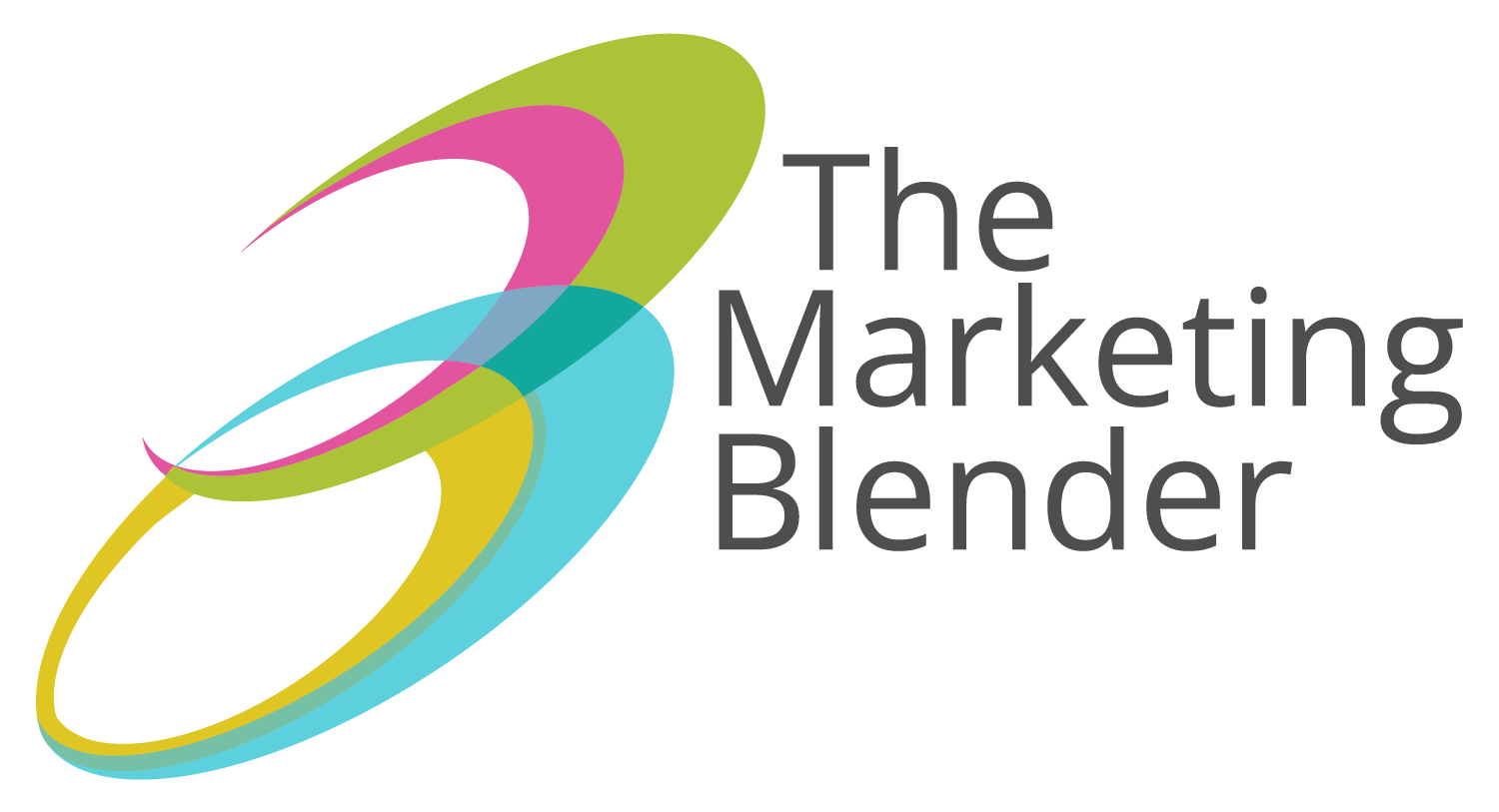How do you know which marketing strategy will drive sales? The most important tip is that a good strategy needs clarity around decision-making criteria and a plan, not just a grouping of tactics. Advice like, “We need to be on social media” or “You need more SEO blog content” are not strategies, they’re tactics.
The best B2B marketing strategies don’t just pile more tactics onto your already full plate. The best marketing strategy for your business maps out how the right tactics will work together to reach the right audience with the right message at the right time.
On this page, we’ll walk through how to build the best B2B marketing strategy to maximize your resources and growth. We’ve distilled the process into six easy-to-follow sections.
The 6 how-to steps to create a winning B2B marketing strategy
You can jump to any section by clicking the links below.
How to create B2B buyer personas to enhance your marketing
How to map your B2B sales cycle and why it matters
How to craft a positioning statement that acts as a catalyst for B2B growth
How to write a messaging framework for B2B marketing and sales alignment
How to choose the right B2B KPIs to optimize your sales and marketing
How to turn your B2B marketing tactics into a powerful marketing plan: The 7 Fundamentals
The achievable goals of the best B2B marketing strategies
There is no “one-size-fits-all” approach to a BtoB marketing strategy. The marketing plan and tactics that garner great results for one B2B company may not work for another. To be effective, you must first clearly identify your goals. Possible B2B marketing goals include:
- Drive brand awareness and visibility to generate demand
- Educate the market
- Improve positioning to avoid commoditization
- Convert interest into inquiry for lead generation
- Generate marketing qualified leads that need to be nurtured
- Generate sales qualified leads that are ready and qualified to buy
- Speed up the sales cycle
- Handle objections and improve closing ratios
- Acquire customers
- Retain clients to turn one-time buyers into repeat customers
- Improve ROI
Once you have aligned on your goals, you can plan and execute the right marketing mix to achieve them and grow your business.
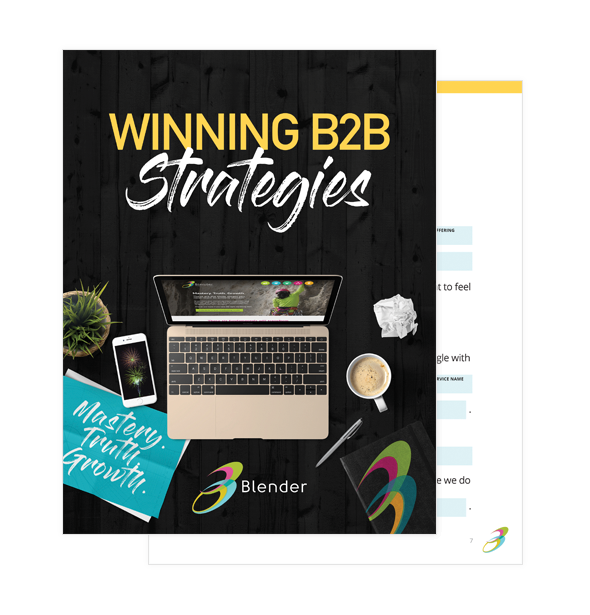
Download our bonus guide: “Winning B2B Marketing Strategies”
It’s full of exercises designed to help you and your team. This is the workbook we use with our own clients in a series of workshops proven to generate successful B2B marketing strategies. It’s yours to utilize whether you decide to work with The Marketing Blender or not.
— STEP ONE —
How to create B2B buyer personas to enhance your marketing
How well do you know your customers? Without a clearly defined target audience, you are throwing marketing dollars away chasing bad leads. A detailed picture of your ideal customer can enhance your marketing and sales efforts.
This is the number-one mistake we see organizations of all sizes make. Without customer clarity, you do not have a workable marketing strategy.
It is not feasible or cost-effective to market to everyone at once, so you must concentrate on your core audience. So, how well do you know your ideal prospects? Who are they? Most B2B owners and sales teams will rattle off a few job titles or big companies they’d love to land as clients. But that’s not enough. A job title tells you nothing about the pain points that your company can solve, their motivations for making a purchase, or how they feel about your solution today.
What is the definition of a buyer persona?
Buyer personas are generalized representations of your ideal customers. Sometimes referred to as marketing personas, they provide a deep understanding of your best prospects, which is crucial to effective marketing, sales, product development and every other touch point related to customer acquisition and retention.
Is taking the time to create B2B buyer personas really worth it?
Properly crafted buyer personas give you a full understanding of what makes your best customers tick. These insights enable you to better answer any possible objections that prospects may have during the sales process and better serve them once they do become customers.
- High-performing companies are 2.3 times more likely to research the drivers of their buyers.
- 71% of companies that exceed revenue and lead goals have documented personas.
- Persona-based content can increase customer engagement almost six-fold when targeting cold leads (10% versus 58%).
- Depending on your business and sales cycle, you could have just one or two personas—or many more. We find most companies generate over 80% of their revenue from just 3–4 buyer personas.
How to create buyer personas for B2B
Buyer personas are built with research. Here are a few practical tips for gathering the information you need.
Talk to your sales team. They know your existing customers best! Ask them to list their impressions and all the details they can about each of their clients.
Send out questionnaires. Email your existing customer base an online survey. If possible, consider offering a small incentive to customers who answer all the questions. (A discount or sample product is a good motivator.)
Update your existing forms. If you have forms on your website, update them to include form fields that capture unobtrusive personal information, such as company size.
Conduct traditional market research. If you have the budget to do so, investing in focus groups with your target customers can uncover new insights.
Interview customers and prospects. Either in person or over the phone, ask them about themselves, their challenges and their needs.
For tips on finding the right people to interview and a list of sample questions, see this blog post on conducting interviews for researching B2B buyer personas.
What information should be included in B2B buyer personas?
The goal is to have enough basic demographic information to find and recognize your ideal customers and all the insights you can get to help you truly get to know and understand them. You should also highlight any unique characteristics of each persona to help your sales team quickly identify which one a prospect falls under and adjust their pitch to address the unique pain points of that buyer persona.
Here are the most important details that every B2B buyer persona should have:
- Location
- Age
- Gender
- Interests outside of work
- Education level
- Job title
- Income level
- Relationship status
- Goals
- Major challenges they face in their job
- What keeps them up at night
- What solution or information they are missing
- What motivates them to make a purchase
- What concerns they have about a potential solution
- What objections they have to making a change
Finally, give your personas catchy names (like CEO Steve or Manager Marge) that convey their role and personality. Also include a photograph of what they might look like. This makes it easy to reference each persona and more natural to think about them as real people. (Remember, a buyer persona is a composite of an ideal customer, not a narrow box that every single prospect must fit perfectly into.)
This information will help you make tactical decisions, such as the best way to communicate, what images to choose, when to contact them, what content they will find interesting, the length of content and much more.
— STEP TWO —
How to map your B2B sales cycle and why it matters
An effective sales process should be goal-oriented, customer-focused, clearly defined, predictable, repeatable, measurable and adaptable.
What is the definition of a B2B sales cycle?
Simply put, a B2B sales cycle is the entire process of making a sale. The B2B sales process consists of a series of steps, events or phases that must occur for a business to sell a product or service to another business.
Why formally mapping your B2B sales cycle is crucial for growth
Given that at least 50% of your prospects are not a good fit for what you sell, it is imperative to reduce inefficiency in your sales process. Having a documented, formal roadmap of your sales process means any member of your sales team can replicate the successful steps it takes to find prospects, address objections, close deals and boost customer loyalty.
Greater efficiency will also help you reap these two important benefits: higher conversation rates and a greater percentage of deals that generate more revenue.
You must sell your company on taking the initiative
Some members of your sales team may think they don’t need the help or might be resistant to change. Executives may not want to allocate time and resources away from “actually selling.” Your internal marketing team may not welcome perceived interference in how they craft marketing messages. So, get a few internal champions onboard with the idea that a detailed map of your sales cycle will make everyone’s job easier and more effective.
B2B sales cycles have gotten harder
In B2B sales, buyers have always followed a predictable, controlled path.
The good old purchase funnel
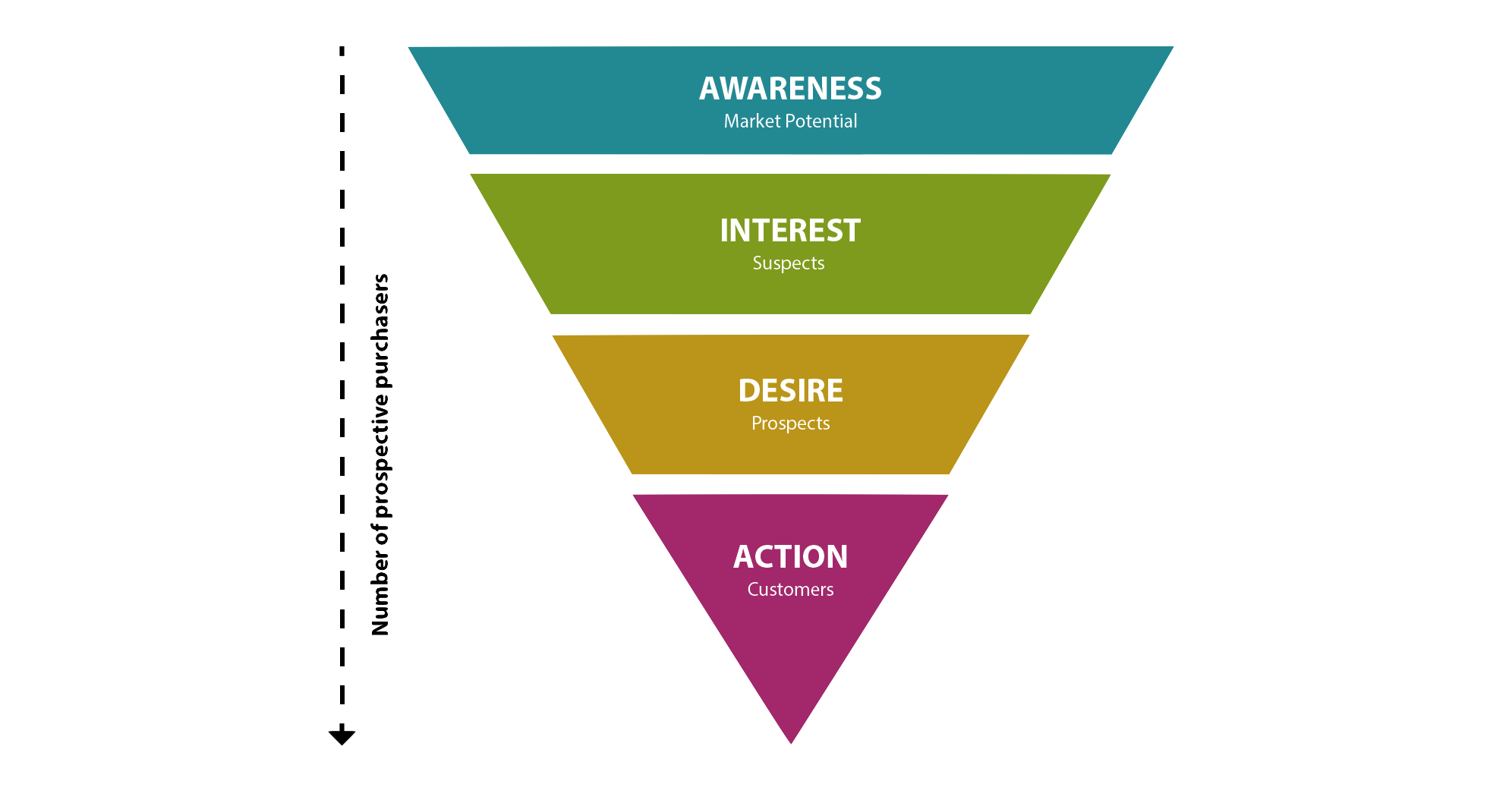 At least, that’s the marketing funnel we all learned in business school. But the B2B landscape has changed. In today’s digital world, the path that B2B buyers take has changed so much that 68% of B2B executives say they have not identified their purchase funnel.
At least, that’s the marketing funnel we all learned in business school. But the B2B landscape has changed. In today’s digital world, the path that B2B buyers take has changed so much that 68% of B2B executives say they have not identified their purchase funnel.
According to a recent CMO survey by Gartner, 77% of B2B buyers feel that making a purchase is very complicated or difficult, calling it “time-consuming” and “painful.”
Why does selling and buying large-scale, complex solutions feel harder than it used to? To state the obvious, there are more cooks in the kitchen. The typical number of stakeholders involved in B2B purchase decisions includes six to ten people with someone in the C-suite having final signoff. And most, if not all, of those folks are doing their own research online. In industrial and manufacturing industries, 67 percent of purchases are influenced by digital.
Today, it makes more sense to view the purchase funnel as TWO separate funnels: the first being the marketing funnel, where the goal is to generate a sales qualified lead, possibly resulting in a live meeting; and the second funnel is the sales pipeline, where the goal is to close the deal.
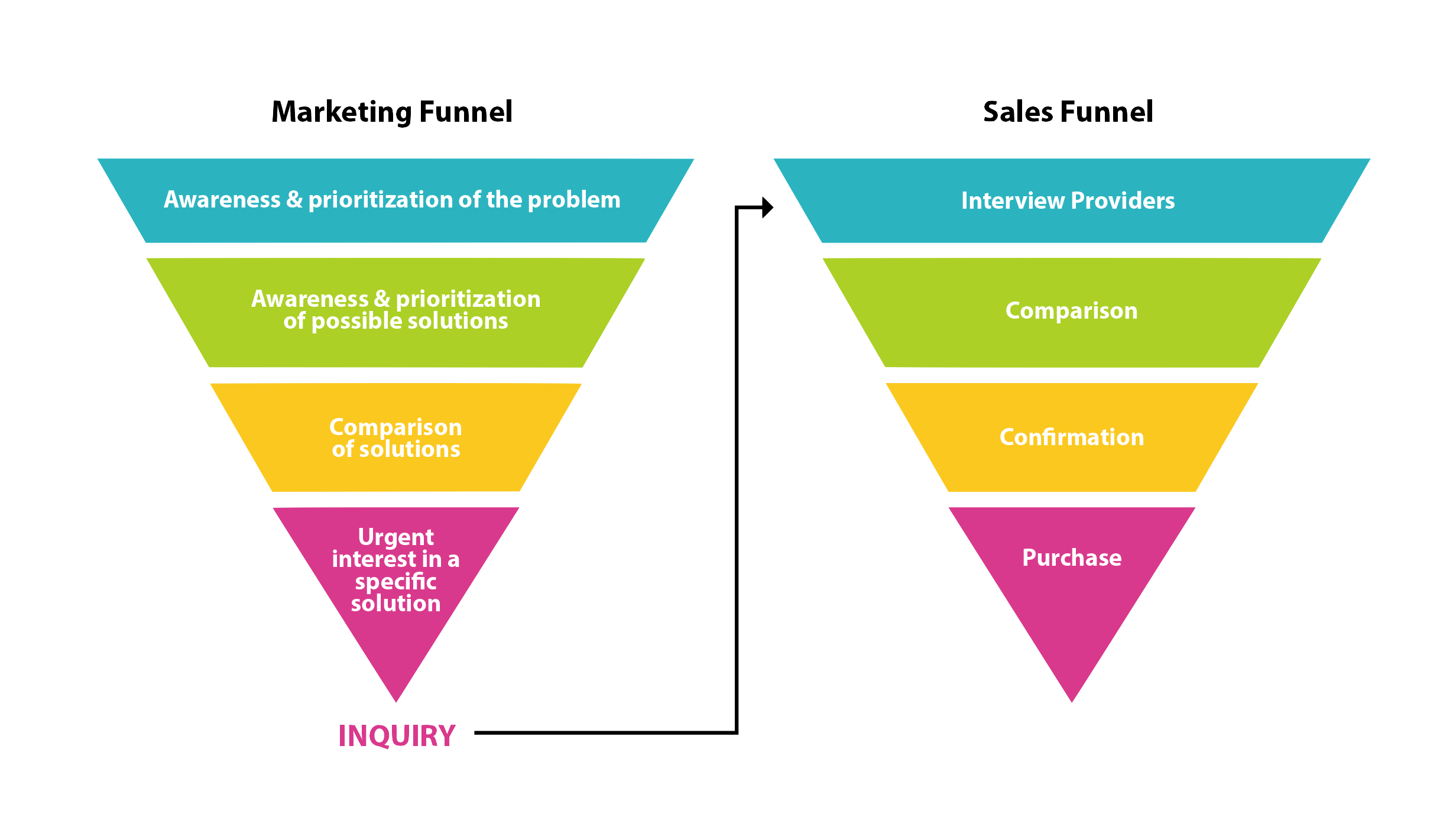
For details on how to map and refine your sales cycle, see this blog post.
Map your marketing strategy to support your sales cycle
At The Marketing Blender, we align the B2B marketing strategies of our clients to their real-world sales cycles.
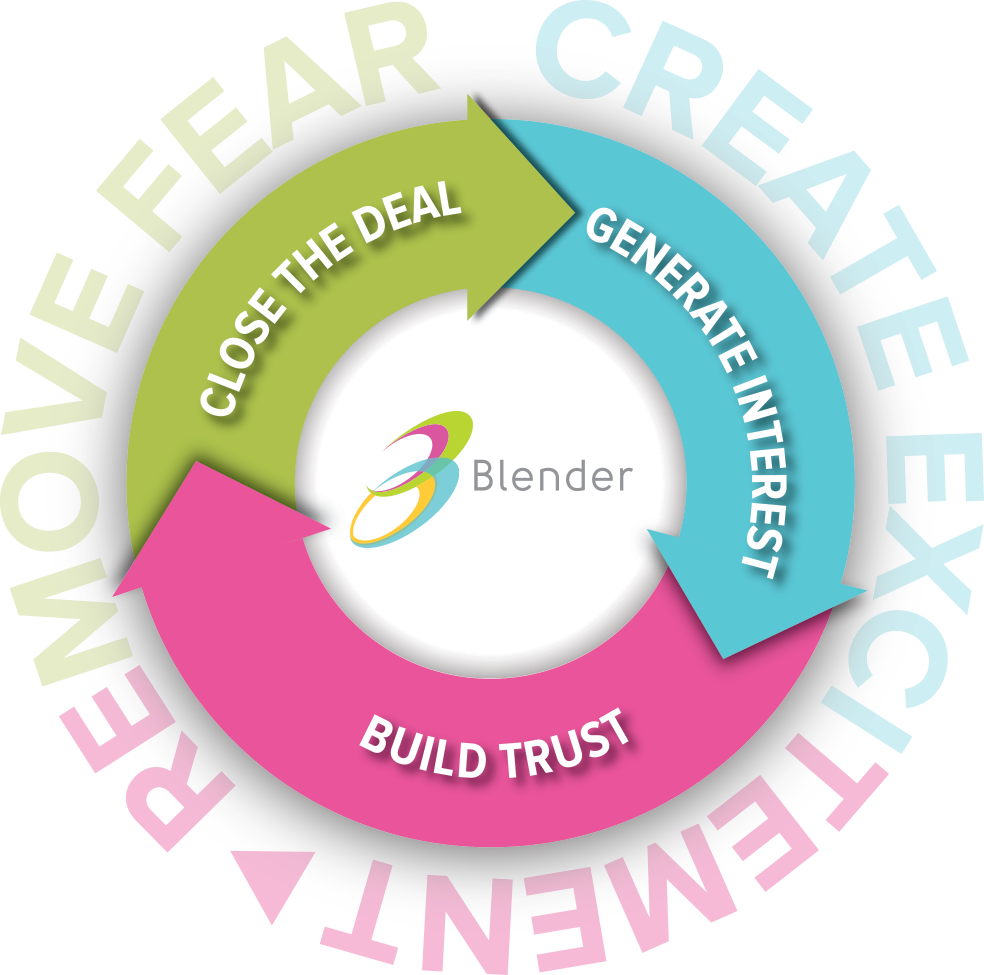
The first half of the circle represents the marketing funnel. The second half represents the sales funnel. This circular graphic helps you see the alignment and collaboration between sales and marketing and how they influence a buyer’s decision-making.
By using this circle to mirror your sales cycle, you can more easily see the buying and selling process in an integrated fashion that helps you maintain a customer-centric point of view.
Here is how you can map your marketing efforts to support the sales conversation and buyer’s journey.
- Document the marketing tools you use by pinning them to the correct segment of the sales cycle. For example, PPC, trade show and advertising are examples of marketing tools you use to generate interest and awareness. Your website belongs in the Build Trust section.
- Identify the triggers and define the actions that move a prospect to the next stage.
- Review and look for areas where your marketing efforts are too thin or where you are losing leads.
- Ask yourself if every call to action you’re using aligns with the buyer’s journey. There are three distinct exchanges of value that you should be asking for. Under Generate Interest, you are asking for attention. In Build Trust, you’re asking for time. And under Close the Deal, you are asking for money.
Pro tip: Be careful not to put a call to action to demo your product or service too early in the process. This can actually slow down the sales cycle if you haven’t given prospects enough information to convince them that spending time with you will be worth their effort.
Now that you have aligned the stages of your sales process to your customer’s buying process, you need to define the objective of each sales stage. What action does a prospect need to take before they are ready to move to the next stage? And what action should your sales rep take to help them?
This is how you’ll refine the map of your sales cycle into the optimal process for success. You should also include how a prospect can be disqualified from your sales process. In addition, ask yourself if you are qualifying leads too late in the process. Don’t waste resources on a prospect that will not convert.

Download our bonus guide: “Winning B2B Strategies”
It’s full of exercises designed to help you and your team draft your marketing strategy. This is the workbook we use with our own clients in our proven strategy workshops.
— STEP THREE —
How to craft a positioning statement that acts as a catalyst for B2B growth
You can give your business an edge by expressing what sets you apart in a succinct, clearly compelling way. You may have heard others describe this as your brand promise or a value proposition. No matter what you call it, it is meant to be the north star that guides you.
A B2B brand promise is defined as the experience and value people receive every single time they interact with your company. It is a pledge that you stake your reputation on. Brand promises are about consistency, personality and memorability.
Think of your positioning statement as a distilled, external-facing version of a company’s vision or mission statement. While your mission and vision statements are meant to inspire internal stakeholders, a brand promise is intended to inspire external loyalty. (If you don’t have a truly inspiring mission and vision statement, you can see why it matters and how to craft one in this blog post.)
A B2B value proposition should convey the value a buyer receives by choosing your product or service. It is the core of your competitive advantage. Ideally, it provides a formula to help prospects quantify your value, so it should clarify a point where you are absolutely incomparable. Ask yourself this: If someone invests their time and money in you, what return will they get and how did their lives transform? How do you help them shift from a problem to an opportunity as a result of having worked with you?
How to write a compelling B2B positioning statement
Your value proposition should express what you do, who you serve and how you’re different. To write your value proposition, start by answering these questions:
- Why do customers choose our business?
- What do we provide that they can’t get elsewhere?
Next, write down the biggest pain points of your customers.
Finally, describe how the traits you selected solve those pain points.
You’ll use the items on the list you just created as the building blocks of your value proposition. Try inserting them into one of the following templates or formulas. Just fill in the blanks.
Your company name is your distinct offering to provide your unique benefit to target customer who wants to feel desired emotional outcome.
For target customer who statement of the need, our product/service name gives describe a desired future state.
We are the company that does X for Y because we do Z.
For more fill-in-the-blanks formulas and templates you can use to write your own positioning statement, see this blog post.
The characteristics of a strong positioning statement
Differentiating. Unless you are extremely lucky, your business has competitors. So, explain what makes you different—and better.
Measurable. If you can’t prove it, it doesn’t matter. So, make sure your value proposition can be compared in a way that customers understand, such as time, quality, emotion or savings.
Simple. Keep it short and sweet. If it’s not immediately obvious, it doesn’t work.
Credible. If a customer’s experience doesn’t live up to your value proposition, you’re toast. To use a buzzword, be “authentic.”
— STEP FOUR —
How to write a messaging framework for B2B marketing and sales alignment
Your B2B messaging framework is the core of how your company relates to your customers. It should be adjusted for each of your buyer personas to directly address their pain points.
What is a B2B messaging framework?
A messaging framework, often called messaging architecture or a messaging playbook, is a set of phrases and statements that are arranged hierarchically to convey the benefits that the company provides for its customers. Simply put, it is the most compelling language you can use to sell.
Why having a B2B messaging playbook is crucial to winning
Most B2B companies make the mistake of talking about themselves, not their customers. Their marketing materials and sales team drone on and on about features and benefits, but completely skip addressing the needs and pain points of their prospects.
A winning B2B messaging playbook clearly empathizes with a customer’s pain and connects your product or service as the solution to that pain. Without this framework in place, your sales and marketing messages are not as strong as they should be.
Even worse, your sales and marketing messages can become muddled without the connective tissue of clear B2B messaging architecture. Every touch point your business has with a customer should speak with a consistent voice and message. And it’s critical that your message be delivered in the order that aligns with the psychology of decision-making. Otherwise, you’re causing confusion and misperception among your employees and customers. Which means you’re blowing potential sales.
By giving your sales team and your marketing team the same B2B messaging map to follow, you create synergy between their efforts. In other words, with standardized messages, your sales reps can more effectively sell the products and services that your marketing is promoting.
What information should a messaging framework contain?
A strong messaging framework should act like a blueprint that enables you to build whatever marketing piece or sales tool you need. So, your B2B messaging blueprint should answer the following questions.
- What rational and emotional pain points trigger a purchase for each of our buyer personas?
- What barriers do our buyer personas need our help to overcome?
- What do we do best to address those pain points and barriers? And how do we describe that solution?
- How does our solution compare to our competitor’s? And how do they describe theirs?
- What are the key talking points we want prospects and customers to know?
- How do those talking points align with our customers’ pain points?
Now you’re ready to put all those insights into action. Write your B2B messaging framework as an easy-to-reference manual that both your sales and marketing teams use to craft all of their communications.
The Marketing Blender B2B messaging choreography
At The Marketing Blender, we develop a powerful messaging framework for each of our clients that aligns their marketing and sales efforts into one consistent and compelling story. Our messaging choreography allows us to craft the most compelling messaging for each of our clients’ buyer personas to drive real results. To do so, we follow a proven hierarchy in the form of a messaging funnel. Because how you tell your story dictates how people feel about buying. How you tell is how you should sell.
The Marketing Blender messaging choreography funnel

For an explanation of each stage of this B2B messaging funnel, see this blog post.

Download our bonus guide: “Winning B2B Strategies”
It’s full of exercises designed to help you and your team draft your marketing strategy. This is the workbook we use with our own clients in our proven strategy workshops.
— STEP FIVE —
How to choose the right B2B KPIs to optimize your sales and marketing
If you can measure it, then you can improve it. A key performance indicator (KPI) is defined as a quantifiable measurement that a company uses to gauge its performance over time. Often referred to as metrics, there is a seemingly endless amount of data that companies can track and analyze, so having clarity around what your marketing can and should accomplish is critical.
The characteristics of the best KPIs for B2B marketing
Ask these two questions when deciding if a KPI is worth paying attention to.
1. Does it align with your strategic or corporate goals?
Does it have a meaningful impact on your performance or revenue? Don’t fall for “vanity metrics” that look good but don’t actually drive business results. If it isn’t relevant, it doesn’t matter.
2. Is it actionable?
Do you have the data and is it accurate? Do you have clear action steps to take when the number goes up, or if it goes down? If a metric doesn’t translate into an insight, it isn’t doing you much good.
Two pieces of advice about KPIs that could save your budget
The right metrics will reveal how your marketing performs and how effective your sales efforts are. Marketers need metrics that not only help improve their campaigns, but also enable them to explain and sell a robust marketing plan to the executives in the C-suite. The right metrics also help you ask the right questions, forming the foundation of continuous improvement and ongoing results.
1. Select KPIs that are linked to clear business goals.
A valuable KPI will indicate if you are making progress toward an identified business goal. Common goals include increasing sales conversions or improving the return on investment (ROI) of your marketing dollars.
2. Keep it simple by focusing on a few key metrics.
If you try to track too much, your team can become overwhelmed and unable to find or act on the insights you need to improve.
Here are a few examples of the many goals that marketing can drive:
Visibility
Metrics:
Web traffic
Click-thru rates (CTR)
Impressions
Share of voice
Followers
Search rankings
Leads
Metrics:
Marketing qualified leads (MQLs)
Sales qualified leads (SQLs)
List size
Conversion rates
Landing page traffic
Time to Sale
Metrics:
Number of touches
Open rates
Time to close
Frequency of communication
Positioning
Metrics:
Share of voice
Publicity mentions
Net promoter score
Search ranking
Reviews
Engagement
Education and Objection Handling
Metrics:
Click-thru rates
Closing ratios
Open rates
Attendance
Followers
Engagement
Time to close
ROI
Metrics:
Cost per lead
Cost of client acquisition
Lifetime client value
Conversion rates
Revenue trends
Ratio of MQLs to SQLs
In general, KPIs fall into two categories: program metrics and revenue metrics.
- Program metrics are the tactical, day-to-day numbers you’ll use internally to gauge the impact of your campaigns, database management and sales-to-marketing alignment.
- Revenue metrics are the strategic, big-picture metrics you’ll share with your executives to demonstrate your contributions to revenue and profit growth.
For a breakdown of KPIs that fall into these two categories, see this blog post.
How KPIs can help take your marketing to the next level
You know that the right data is a useful tool for improving your marketing and sales efforts. Another big payoff comes when you begin to automate your data collection process. B2B marketing automation offers tools to identify, track and analyze your key metrics. It also helps you maintain consistency, a key to ongoing marketing success.
— STEP SIX —
How to turn your B2B marketing tactics into a powerful marketing plan:
The 7 Fundamentals
The right mix of these crucial tools will transform your business and boost sales.
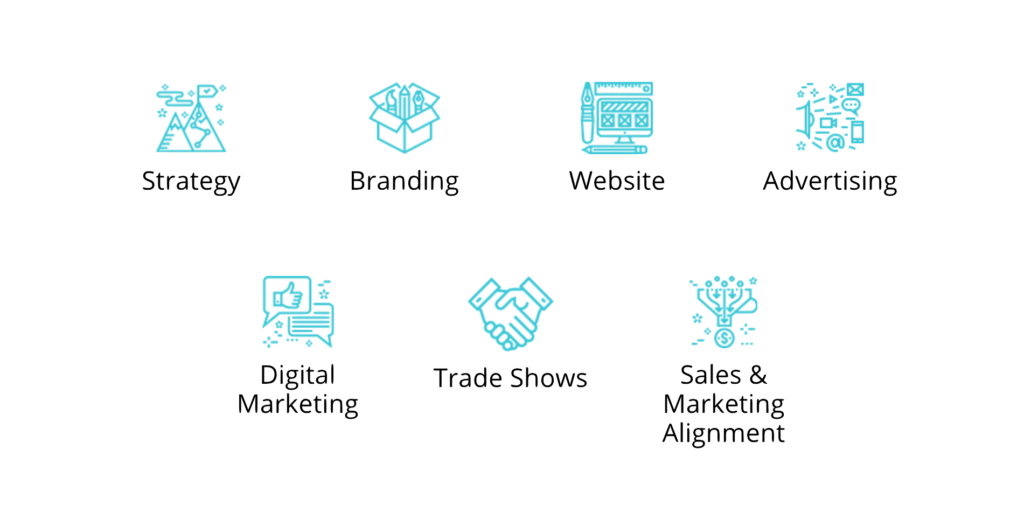
Strategy
As we’ve related, strategy dictates who you should target, where you can find them and what you should say to motivate them to choose you. Your marketing plan determines how to spend smart money to engage your target and measure results. See how a marketing plan can align your sales and marketing efforts here.
Branding
Your brand is not just your logo. It is your truth. It is the culmination of every touch point your prospects and customers interact with. It all adds up to what buyers think of your business and how they rank it against your competitors. People buy with their eyes, so protect how you are perceived. Great branding is also closely related to premier pricing, healthy lead generation and protecting yourself from commoditization. See more on why branding matters to B2B growth here.
Website
Your website should be your best sales tool, and should address the needs of buyers at each stage of their purchase journey. It should give them a clear path to take action, while clarifying insights that reinforce why they should choose you over your competitor. An effective website should feature:
- Campaign landing pages
- Clear calls to action
- Engaging video
- Testimonials or other social proof
Advertising
Advertising is how you reach your widest target audience to generate awareness. It is about attracting attention, not educating or selling. Every ad must catch the eye and deliver a clear, compelling message that piques curiosity. There’s a wide range of tools in the advertising world, such as:
- Print ads
- Events
- Sponsorships
- Joint ventures
- Signage
- TV
- Radio
- Podcasts
- Public relations
Digital Marketing
While it remains the most underutilized opportunity in B2B, digital tactics can have a truly transformative impact on sales. With the right approach, you can effectively target the right decision-makers at multiple places along their buyer’s journey. The key is finding the right mix of these digital tools:
- Social media
- Paid social
- SEO
- PPC
- Surveys
- Downloads
- Remarketing
- Webinars
- Landing pages
- Microsites
- Apps
- Virtual reality
- Augmented reality
- Gamification
- Portals
- AI
- SMS marketing
Find out how to take the initiative in digital before your competitor does here.
Trade Shows
More broadly categorized as event marketing, this is a proven tool for business-to-business marketing and sales. Face-to-face conversations are powerful, but pre-show preparation and post-show follow-up are where you can really make an impact. Tracking your follow-up and results is non-negotiable.
See how to maximize your ROI and lead generation here.
Sales & Marketing Alignment
Every piece of communication from your company adds up to one experience in a prospect’s mind. And if your messaging isn’t aligned across every sales and marketing touch point, it can sabotage your sales cycle. Consider the following:
- E-signatures
- Documented sales process
- Smart use of collateral
- Sales presentations and pitch decks
- Marketing training
- Sales cycle mapping and strategy
- Automation
- Lead scoring
- Referral programs
- Lead nurturing
- Objection-handling content
See how to align and optimize your sales and marketing efforts here.
